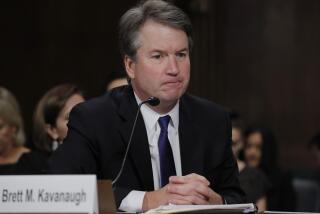Challenges Facing Shuttle Disaster Inquiry Include Culture at NASA
- Share via
HOUSTON — The elevator doesn’t work, so a man with a bad knee has been struggling up and down the stairs all week.
The telephones that were delivered were equipped with only one line, so every time an employee checks her voicemail, more messages stack up.
No one can figure out which parking spaces they’re supposed to use, so tickets keep appearing under the windshield wipers of rental cars.
In short, the nondescript office building off Saturn Lane was a mess when a white-haired, rail-thin man with a slight stoop walked inside recently. With a meek smile, the man flashed his ID badge at a security guard. Under one arm, he was carrying his lunch in a Tupperware bin.
It would be easy to dismiss this place, the new offices of the Columbia Accident Investigation Board, the independent panel appointed by NASA to find the cause of the space shuttle accident that occurred one month ago. That would be a mistake, say those inside.
The man carrying his lunch was retired Adm. Harold W. Gehman Jr., the chairman of the investigation board, NATO’s former supreme allied commander for the Atlantic and the man who led the inquiry into the 2000 suicide bombing of the U.S. destroyer Cole in Yemen.
It’s no easy task to establish a bureaucracy on the run. And the pressure is on Gehman, 60, to produce, even as questions build about whether he has assembled a team that can remain independent of NASA.
The first apparent schism between NASA and the board opened late last week when Gehman wrote to NASA Administrator Sean O’Keefe, suggesting that senior NASA officials with close ties to the shuttle program be removed from any involvement with the investigation.
O’Keefe rebuffed the recommendation Saturday, saying reassigning those employees would prejudice the investigation. O’Keefe, however, agreed to reorganize the agency’s efforts in other ways to better assist the board.
A month after it began, it has become clear that this investigation will be more complex than the probe that followed the space shuttle program’s other disaster, the Challenger explosion in 1986. Then, some NASA engineers believed they knew the cause of the accident within three hours.
This time, “what is starting to jump out is that nothing is starting to jump out,” Gehman said recently.
But armed with $10 million, Gehman has put together a lean collection of the nation’s and the military’s top aviation accident investigators.
A Norfolk, Va., native, a Vietnam veteran and a student of the principles of war, Gehman has pledged to produce, within six months, not just a technical review of the Columbia but a virtual blueprint that America’s troubled space program can use to regain traction.
And although he says the board is not out to find a “guilty party,” Gehman has made it clear that investigators will be looking at the culture of America’s space program, particularly at the people who manage it.
“If you have a secretary and a potted plant outside your office, you are fair game,” Gehman said.
Each day, investigators -- in an overt attempt to appear more forthcoming than NASA was after Challenger -- have released tantalizing details about the accident and the evidence they are assembling.
This week, the investigation board said it is studying a large piece of Columbia’s left wing discovered in East Texas. The piece appears to show significant damage to 13 of the shuttle’s ceramic tiles, designed to protect it from the dangerously high temperatures encountered during reentry. That piece is considered particularly significant because it could help prove that debris opened a wound on or near the shuttle’s landing gear door.
So far, though, the cause of the accident remains a mystery.
The board has concluded that Columbia suffered a breach of its thermal protection system. Investigators believe that breach allowed superheated gas known as plasma to penetrate the craft, possibly through the seams of the landing gear wheel well under the left wing.
Investigators say they have not determined what caused the breach, but are delving into the most evident problem earlier in the mission -- the moment, shortly after the Jan. 16 liftoff, when foam insulation fell from a fuel tank and struck the left side of the shuttle.
They are also interested in two troubling developments.
Members of the board said in interviews that they are concerned that Boeing Co.’s analysis of the liftoff incident -- which concluded that the shuttle would return safely -- was incomplete or inadequate. Boeing says it stands by its work.
The board also is interested in e-mails midlevel NASA engineers sent to one another in the final days of the mission. NASA repeatedly has sought to assure the public that it was unified in the belief that the liftoff accident did not pose a threat to the crew. But several of its own engineers continued to question that diagnosis up to the day before the Columbia was to land. One engineer suggested that NASA was treating his requests for more information like “the plague.”
Many analysts say they already see some likely proposals from the board. They expect the panel to recommend changes to the method of insulating fuel tanks, for example, regardless of whether the board concludes the foam insulation caused the breach.
Still, with so many tentacles and so few answers, many question whether Gehman would be able to point conclusively to the precise cause of the accident.
“There is no smoking gun here,” said John Lindner, an associate professor of physics at the College of Wooster in Ohio, who specializes in studying the potential effect of debris on shuttles. “This could be difficult, and it may be that we never know exactly what happened. But I’m optimistic. These are the best people in the business.”
The board has not given itself an absolute deadline, but Gehman has told congressional leaders he expects answers in two to six months.
NASA officials hope they can get a preliminary finding in 5 days, allowing them to begin making fixes that would enable the shuttle fleet to get in the air again, said retired Air Force Maj. Gen. Michael Kostelnik, NASA’s deputy associate administrator for space shuttle programs.
Congress has appropriated $50 million for the Columbia probe. NASA has given $10 million of it to the investigative board and is keeping the rest, largely to pay for the exhaustive effort to recover pieces of debris.
Aides say Gehman, who declined requests for interviews, is attempting to put together an investigative organization that reflects a changing culture in Washington -- a group free of red tape, more nimble than the antiquated bureaucracies that have long been a hallmark of the federal government.
Although it’s clear that Gehman “is in charge,” said board spokesman Air Force Lt. Col. Woody Woodyard, he has established a relatively “flat” structure -- meaning, in layman’s terms, that there are few bosses and that board members are free to set their own course.
“They are not worried about titles,” Woodyard said. “They are worried about getting the job done.”
The 10-member investigative board is heavy with high-ranking military officers and former Pentagon officials. It includes, for example, former Air Force Secretary Sheila Widnall, now an aeronautics professor at MIT, and Brig. Gen. Duane W. Deal, commander of the Air Force’s 21st Space Wing.
About 30 staff members and advisors with a wide array of specialties have been hired. For example, the board has enlisted the assistance of Lt. Col. Donald J. White, a physiologist by training and the director of human-factors investigation and analysis at Kirtland Air Force Base in Colorado. Gehman’s aides say additions like that could be critical in understanding how human factors, including questionable communication lines at NASA, might have contributed to the accident.
The board members’ ties to the military and the aerospace community have brought criticism that they are too close to NASA to pull off a truly independent investigation. Gehman disputed that.
“These are the most senior and most talented aviation mishap investigators in the country,” he said during a news briefing last month. “Nobody is going to put that reputation on the line ... and allow themselves to be [improperly] influenced.”
When Gehman went to Capitol Hill last week, he met with about a dozen senior lawmakers, many of whom are critical of NASA’s management of the space program and want to make sure the board will be firm and frank in its assessment of the space agency.
Rep. Dana Rohrabacher (R-Huntington Beach), chairman of the House subcommittee on space and aeronautics, said Gehman “impressed us with his professionalism,” but he stopped short of saying he is satisfied with the board’s progress.
“Let me have a couple days to study that,” Rohrabacher said. “My gut instinct tells me I can trust the admiral to put together the very best team. But you get to a point where you have too many people involved, and it can bog things down.”
Faced with such skepticism, the board has taken steps to guard the information it collects.
The board’s interviews with employees at a variety of NASA installations, from Kennedy Space Center in Florida to the east New Orleans plant where foam insulation is sprayed onto external fuel ranks, are legally “privileged.” That means the public and the media do not have the right to listen to those interviews, nor to hear recordings of them. The board has no legal obligation to even disclose the names of people it interviews.
The intent of the secrecy is to allow NASA’s employees and its contractors to speak without fear that their allegations will become matters of public record, said board spokeswoman Laura Brown. The privileged status fosters an environment of cooperation and comfort, she said.
Board members have considered whether issues of criminal liability could surface in the course of the investigation, aides said, though there is no evidence to date that criminal charges are expected. The board’s charter explicitly prohibits it from bringing criminal charges itself, so those matters would be referred to the Justice Department, Brown said.
Nancy Herrera, an executive assistant U.S. attorney in Houston and a spokeswoman for U.S. Atty. Michael T. Shelby, declined to say whether her office is cooperating with the board.
“The Department of Justice does not confirm or deny the existence of an investigation,” she said. “Nor do we provide opinions about the possibility of criminal charges being filed.”
More to Read
Sign up for Essential California
The most important California stories and recommendations in your inbox every morning.
You may occasionally receive promotional content from the Los Angeles Times.















